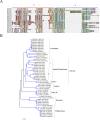An insight into the sialome of blood-feeding Nematocera
- PMID: 20728537
- PMCID: PMC2950210
- DOI: 10.1016/j.ibmb.2010.08.002
An insight into the sialome of blood-feeding Nematocera
Abstract
Within the Diptera and outside the suborder Brachycera, the blood-feeding habit occurred at least twice, producing the present day sand flies, and the Culicomorpha, including the mosquitoes (Culicidae), black flies (Simulidae), biting midges (Ceratopogonidae) and frog feeding flies (Corethrellidae). Alternatives to this scenario are also discussed. Successful blood-feeding requires adaptations to antagonize the vertebrate's mechanisms of blood clotting, platelet aggregation, vasoconstriction, pain and itching, which are triggered by tissue destruction and immune reactions to insect products. Saliva of these insects provides a complex pharmacological armamentarium to block these vertebrate reactions. With the advent of transcriptomics, the sialomes (from the Greek word sialo = saliva) of at least two species of each of these families have been studied (except for the frog feeders), allowing an insight into the diverse pathways leading to today's salivary composition within the Culicomorpha, having the sand flies as an outgroup. This review catalogs 1288 salivary proteins in 10 generic classes comprising over 150 different protein families, most of which we have no functional knowledge. These proteins and many sequence comparisons are displayed in a hyperlinked spreadsheet that hopefully will stimulate and facilitate the task of functional characterization of these proteins, and their possible use as novel pharmacological agents and epidemiological markers of insect vector exposure.
Published by Elsevier Ltd.
Figures




Similar articles
-
An insight into the sialome of the frog biting fly, Corethrella appendiculata.Insect Biochem Mol Biol. 2014 Jan;44:23-32. doi: 10.1016/j.ibmb.2013.10.006. Epub 2013 Oct 26. Insect Biochem Mol Biol. 2014. PMID: 24514880 Free PMC article.
-
Insight into the sialome of the Black Fly, Simulium vittatum.J Proteome Res. 2009 Mar;8(3):1474-88. doi: 10.1021/pr8008429. J Proteome Res. 2009. PMID: 19166301 Free PMC article.
-
An insight into the sialome of the horse fly, Tabanus bromius.Insect Biochem Mol Biol. 2015 Oct;65:83-90. doi: 10.1016/j.ibmb.2015.09.002. Epub 2015 Sep 11. Insect Biochem Mol Biol. 2015. PMID: 26369729 Free PMC article.
-
Sensory mechanisms for the shift from phytophagy to haematophagy in mosquitoes.Curr Opin Insect Sci. 2022 Aug;52:100930. doi: 10.1016/j.cois.2022.100930. Epub 2022 May 14. Curr Opin Insect Sci. 2022. PMID: 35580800 Review.
-
Visual ecology of biting flies.Annu Rev Entomol. 1987;32:297-316. doi: 10.1146/annurev.en.32.010187.001501. Annu Rev Entomol. 1987. PMID: 2880551 Review.
Cited by
-
Survey for positively selected coding regions in the genome of the hematophagous tsetse fly Glossina morsitans identifies candidate genes associated with feeding habits and embryonic development.Genet Mol Biol. 2020 Jun 10;43(2):e20180311. doi: 10.1590/1678-4685-GMB-2018-0311. eCollection 2020. Genet Mol Biol. 2020. PMID: 32555940 Free PMC article.
-
Unique thrombin inhibition mechanism by anophelin, an anticoagulant from the malaria vector.Proc Natl Acad Sci U S A. 2012 Dec 26;109(52):E3649-58. doi: 10.1073/pnas.1211614109. Epub 2012 Dec 5. Proc Natl Acad Sci U S A. 2012. PMID: 23223529 Free PMC article.
-
Towards a Proteomic Catalogue and Differential Annotation of Salivary Gland Proteins in Blood Fed Malaria Vector Anopheles culicifacies by Mass Spectrometry.PLoS One. 2016 Sep 7;11(9):e0161870. doi: 10.1371/journal.pone.0161870. eCollection 2016. PLoS One. 2016. PMID: 27602567 Free PMC article.
-
Surface Polar Lipids Differ in Male and Female Phlebotomus papatasi (Diptera: Psychodidae).J Med Entomol. 2014 Nov 1;51(6):1237-1241. doi: 10.1603/ME14117. J Med Entomol. 2014. PMID: 25814772 Free PMC article.
-
Human IgG responses to the Aedes albopictus 34k2 salivary protein: analyses in Réunion Island and Bolivia confirm its suitability as marker of host exposure to the tiger mosquito.Parasit Vectors. 2022 Jul 20;15(1):260. doi: 10.1186/s13071-022-05383-8. Parasit Vectors. 2022. PMID: 35858924 Free PMC article.
References
-
- Abebe M, Cupp MS, Champagne D, Cupp EW. Simulidin: a black fly (Simulium vittatum) salivary gland protein with anti-thrombin activity. J. Insect Physiol. 1995;41:1001–1006.
-
- Abrahamson M, Alvarez-Fernandez M, Nathanson CM. Cystatins. Biochem Soc Symp. 2003:179–99. - PubMed
-
- Albert S, Bhattacharya D, Klaudiny J, Schmitzova J, Simuth J. The family of major royal jelly proteins and its evolution. J Mol Evol. 1999;49:290–7. - PubMed
Publication types
MeSH terms
Substances
Grants and funding
LinkOut - more resources
Full Text Sources

